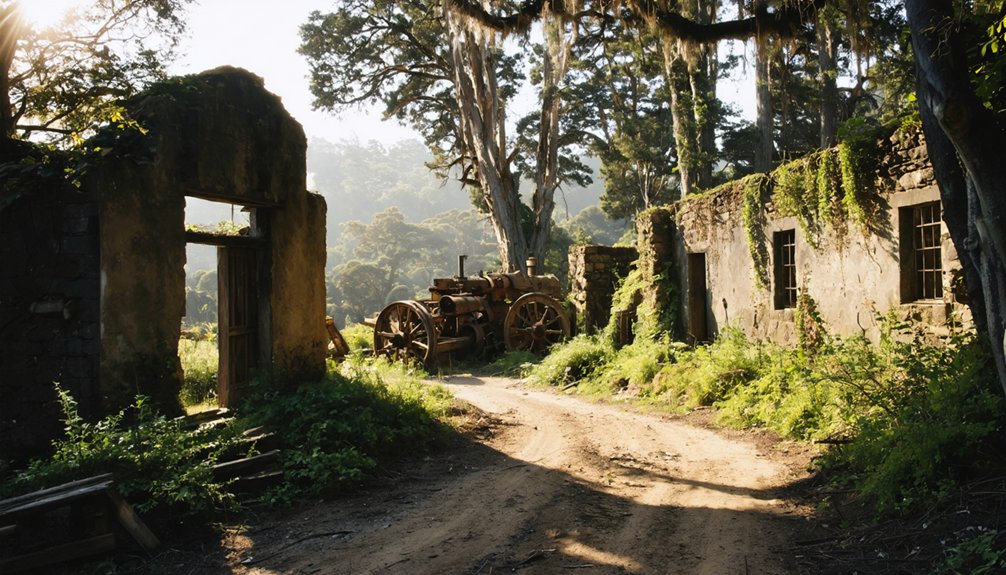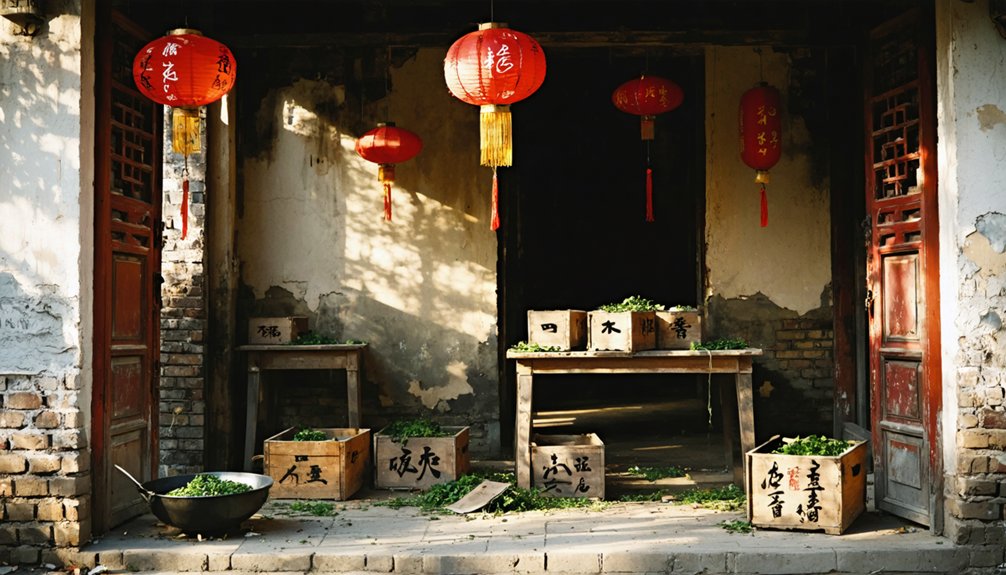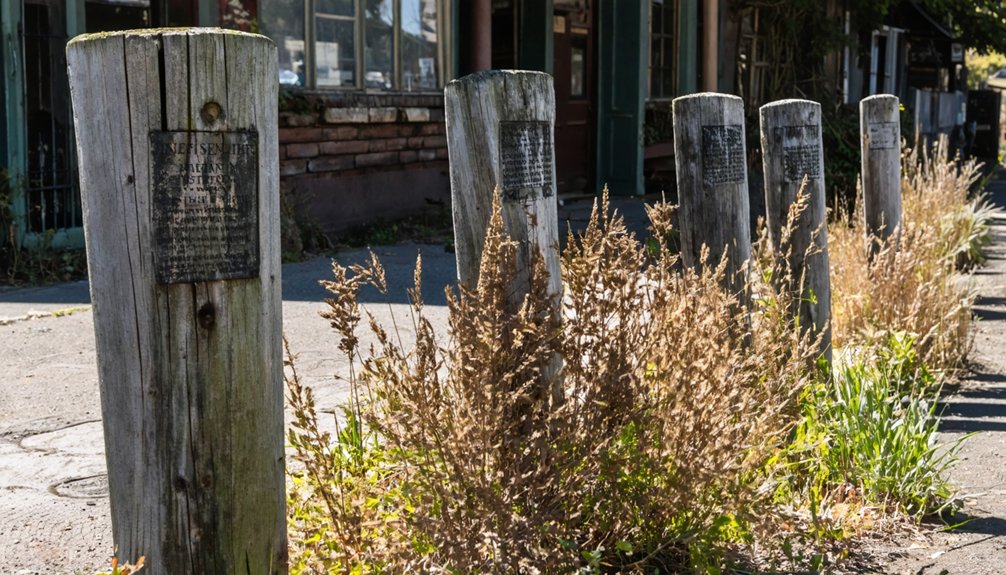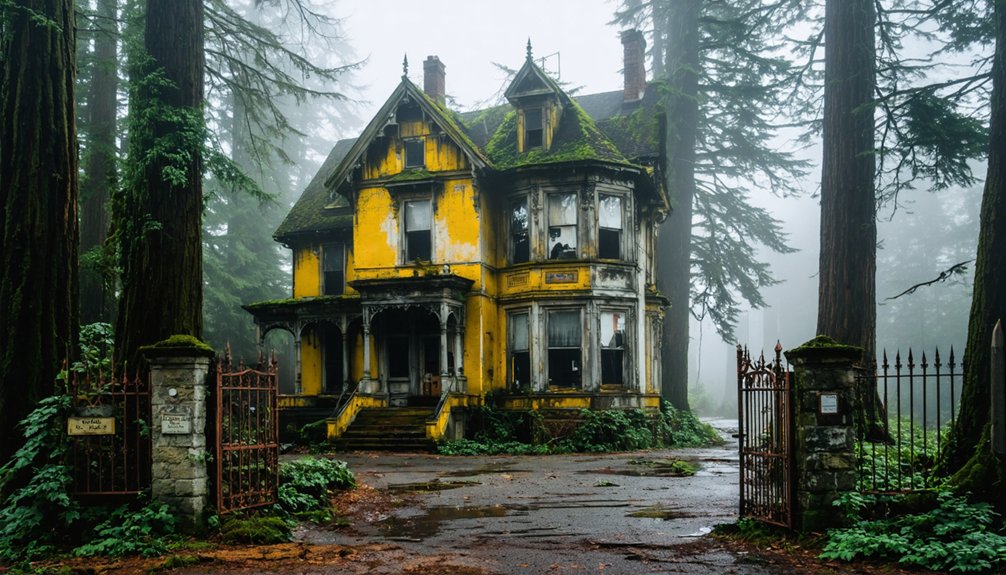While Mill Valley isn’t technically a ghost town, you’ll find haunting echoes of its past throughout the area. The Fireside Motel, built over sacred Miwok burial grounds, attracts paranormal investigators after human remains were discovered during 1957 renovations. Throughout town, abandoned Gold Rush-era structures and weathered facades tell stories of economic collapse following the mining boom. Local preservation efforts continue fighting to protect these historic sites from modern development. The spirits of Chief Marin’s people still linger among the redwoods.
Key Takeaways
- The Fireside Motel in Mill Valley is reportedly haunted, built over sacred Coast Miwok burial grounds with human remains discovered in 1957.
- Mill Valley contains abandoned landmarks reflecting economic collapse after the Gold Rush era, with equipment graveyards marking industry transitions.
- Ghost encounters and paranormal phenomena at Mill Valley sites attract investigators and contribute to the area’s haunted reputation.
- Once-thriving Gold Rush settlements near Mill Valley declined as mining operations shifted, leaving behind hydraulic-scarred hillsides and weathered facades.
- Mill Valley’s Historic Resources Inventory identified 176 potentially historic properties, including preserved structures from the area’s pioneer era.
The Forgotten Indigenous Past: Huimen Coast Miwok Heritage
While modern Mill Valley exists as a vibrant community nestled at Mount Tamalpais’s base, its deeper story begins millennia before European arrival with the Huimen Coast Miwok people.
When you walk through Mill Valley today, you’re treading on land that supported indigenous civilization for approximately 4,000 years, though oral histories trace their presence back 10,000 years.
The Huimen weren’t merely passing through—they built a thriving society with sustainable practices reflecting profound ancestral knowledge.
Their cultural resilience manifested through the Kuksu religion, which honored O’ye the Coyote deity and emphasized ecological balance. They maintained oak groves, implemented controlled burns after seed harvests, and established over 600 village sites across their territory.
The 5,000-year-old shellmounds discovered in Marin testify to their enduring connection to this land long before it was called Mill Valley. The area was later named after Chief Marin, a notable leader during the Spanish Mission period. Many important Miwok cultural sites have been damaged by souvenir hunters and urban development, highlighting the ongoing challenge of preservation.
Unearthed Artifacts: Nelson’s 1907 Archaeological Discoveries
In 1907, archaeologist Nels Nelson made groundbreaking discoveries that would forever change our understanding of Mill Valley’s ancient past. You can trace his footsteps to Locust Avenue, where he unearthed a significant Coast Miwok village site containing obsidian projectile points, shell beads, and human remains in loosely flexed burial positions adorned with red ochre.
The archaeological significance of Nelson’s work lies in his meticulous documentation of shell mounds rising 20 feet high along Richardson Bay and nearby streams. These sites, dating between 2,500-1,100 years B.P., established the Bay Area as a distinct archaeological region. Interestingly, the avenue where these discoveries were made shares its name with insects known for their devastating swarming behavior when transitioning from solitary to gregarious phases.
Sadly, many locations he recorded have since been destroyed by development, highlighting ongoing challenges in artifact preservation. His pioneering methods transformed how we view these shell mounds—not as mere refuse, but as cultural treasures.
The Fireside’s Dark Secret: Building on Sacred Burial Grounds
When you visit The Fireside today, you’re standing atop what was once sacred Miwok burial grounds, a fact confirmed by the shocking discovery of human remains during 1957 renovations.
The unceremonious construction of this 1916 roadhouse directly over these ancient graves reveals a callous disregard for indigenous cultural heritage that was common during that era.
You’ll find the building’s reputation for paranormal activity—strange noises and unexplained disturbances reported since the mid-1950s—is inextricably linked to this disturbing foundation, with locals attributing the phenomena to unsettled spirits whose final resting place was violated. Archaeological excavations throughout Mill Valley have uncovered numerous shell mounds and artifacts dating back thousands of years. A 2007 renovation further disturbed the site, revealing that the establishment was indeed built on a Miwok burial ground.
Ancient Remains Below Floorboards
Beneath the weathered floorboards of the now-abandoned Fireside Motel lies one of Mill Valley’s most disturbing historical oversights.
The structure stands directly atop an ancient Coast Miwok burial site of profound cultural significance, constructed without proper archaeological assessment or indigenous consultation.
When architects positioned the building, they unknowingly desecrated sacred ground where Huimen ancestors had been laid to rest for generations before European contact.
The violation remained unaddressed throughout the motel’s operational years. Unlike Skidoo’s well-preserved stamp mill remains, this site offers no historical appreciation for what was lost. Similar to how hydraulic mining at North Bloomfield caused environmental devastation, the motel’s construction resulted in cultural destruction that cannot be undone.
- Ancient tools and ceremonial items rest mere inches below the concrete foundation
- Seventeen displaced Huimen people who survived the mission era originated from this very land
- The burial grounds connect to the larger network of sacred sites where Chief Marin once walked
Spirits Haunting Local Landmark
The Fireside Motel stands as Mill Valley’s most notorious paranormal hotspot, its weathered walls harboring spirits that many locals believe originated from the Coast Miwok burial grounds beneath its foundation.
Built 92 years ago during the Bay Area’s rough-and-tumble era, this gateway landmark inadvertently disturbed sacred indigenous resting places.
You’ll hear whispers of haunted experiences throughout town—mysterious sounds echoing through corridors and apparitions glimpsed in peripheral vision. These ghostly encounters have made the Fireside a magnet for paranormal investigators and folklore enthusiasts alike. Visitors often report feelings of being watched, similar to experiences documented at Cerro Gordo Mines where preservation efforts continue despite paranormal activity.
The disturbance has sparked important conversations about respecting Native American heritage. While the motel has changed physically over decades, its spiritual significance remains intact, serving as both cautionary tale and cultural touchstone in Mill Valley’s complex identity.
Disruption of Sacred Sites
Fireside Motel’s foundations rest upon what local tribal elders confirm was once sacred Coast Miwok burial grounds, part of a pattern tragically common throughout Marin County.
When you walk these paths, you’re treading where ancient ceremonial items once lay undisturbed for millennia before developers paved over history for profit. The site contained remarkable artifacts including stone tools and trade idols that provided significant insight into indigenous life. Similar to the neglect of the Marin County Poor Farm Cemetery where approximately 600 individuals were buried from 1880 to 1955, these sacred grounds suffer from insufficient recognition and preservation.
Indigenous resilience continues despite this cultural erasure:
- The “grandfather midden” contained 600 human burials dating back 4,500 years—older than King Tut’s tomb
- Rare California condor burials and ceremonial artifacts spoke to deep spiritual connections now severed
- Shellmounds once numbered over 425 across the Bay Area, now nearly all destroyed beneath shopping centers and housing developments
Sacred preservation remains an ongoing struggle as Mill Valley’s hidden history lurks beneath its modern veneer, challenging our commitment to honoring what came before us.
From Mexican Ranchos to American Settlement

You’re standing on land that once formed part of vast Mexican ranchos, divided after 1834 when authorities parceled out Coast Miwok ancestral territories to soldiers and allies of the Mexican governor.
John Thomas Reed’s arrival in 1826 and his sawmill on Cascade Creek would inspire Mill Valley’s eventual name, while William Richardson’s settlement helped establish early development patterns in the region.
The shift to American control marked a pivotal change, culminating in the significant 1890 land auction where 200 acres sold for $300,000, opening the area to new settlement and tourism.
Mexican Land Grants
Following Mexico’s independence from Spain in 1821, vast tracts of Marin County’s lush, rolling landscapes were divided into sprawling ranchos through a system of land grants designed to encourage settlement and economic growth.
You’d find Mill Valley’s future terrain primarily split between two influential grants: Rancho Corte Madera del Presidio (John Reed’s 7,845 acres) and Rancho Saucelito (William Richardson’s 19,000 acres).
These grants fundamentally transformed land ownership patterns, replacing communal indigenous stewardship with private property rights under Mexican law—while simultaneously causing cultural displacement of native Miwok communities.
- Reed’s family established orchards and livestock operations amid the redwood-covered hillsides.
- Property boundaries often followed natural features like the Arroyo Corte Madera del Presidio creek.
- Indigenous Miwoks found themselves working as laborers on lands they once freely inhabited.
American Settler Arrival
The Bear Flag Revolt of 1846 and subsequent Mexican-American War dramatically altered Mill Valley’s destiny, transforming the region from sprawling Mexican ranchos to a patchwork of American settlements within just a few decades.
Though the Treaty of Guadalupe Hidalgo promised to protect Mexican landowners’ rights, the 1851 Land Act forced Californios to prove their claims through costly legal battles they often lost.
Settler motivations varied—some sought gold rush opportunities, while others envisioned agricultural prosperity in Mill Valley’s fertile lands.
As Americans established sawmills, dairy farms, and orchards, they introduced new farming techniques that reshaped the local economy.
This influx accelerated cultural assimilation, with English replacing Spanish and American institutions supplanting Mexican traditions.
The railroad’s 1889 arrival sealed the transformation, connecting Mill Valley to San Francisco and forever altering its rural character.
Wells Fargo’s Brick Sentinel: Last Stand on Main Street
Standing proudly against the backdrop of Mill Valley’s forgotten landscape, Wells Fargo’s brick sentinel on Main Street represents the last physical tribute to a once-thriving boomtown economy.
Built during the Gold Rush era, this fireproof structure served as a lifeline for early settlers, connecting remote mining settlements to larger markets through stagecoach routes.
When you visit today, you’ll notice:
- Iron window shutters and balconies, transported from as far as Troy, New York
- The strategic two-story design with commercial space below and offices above
- Thick brick walls that withstood fires that consumed neighboring wooden structures
Wells Fargo’s brick architecture wasn’t just practical—it symbolized permanence and security in uncertain times.
In a wilderness of ambition, these red brick fortresses stood as monuments to stability amid California’s golden chaos.
Like sentinels guarding California’s economic frontier, these buildings preserved the gold, mail, and valuables that fueled your ancestors’ dreams of prosperity.
The Tong War Legacy: First Chinese Gang Conflict on American Soil

Beneath the rustling pines of Mill Valley’s abandoned streets lies a hidden chapter of American history—California’s first Tong War, which erupted in 1854 when the Yum Wo and Sam Yup Companies clashed violently over disputed mining claims.
As you walk these forgotten paths, imagine the spectacle: over 500 Chinese immigrants battling with traditional pikes and shields while 2,000 onlookers watched.
These mutual aid societies, or “tongs,” originally formed to protect their countrymen in a hostile land, eventually evolved into organizations controlling territory and illegal enterprises.
Mill Valley’s conflict marked the beginning of decades of tong warfare that would spread throughout the West.
The violence partly stemmed from Chinese immigrants’ exclusion from legal protections, forcing communities to create their own systems of order—sometimes with brutal consequences.
Abandoned Landmarks: The Post-Gold Rush Decline
Once bustling with the feverish activity of fortune seekers, Mill Valley’s landmarks now stand as hollow shells of their former glory, silent witnesses to the dramatic economic collapse that followed the Gold Rush.
As you walk these abandoned structures, you’ll notice three distinct remnants of mining impact:
- Hydraulic-scarred hillsides where exposed earth remains barren even generations later.
- Former saloons and theaters with weathered facades, hastily abandoned when gold deposits became unprofitable.
- Equipment graveyards where machinery stands rusting, marking the shift from individual prospectors to industrial operations.
What you’re seeing represents California’s painful shift. When surface gold vanished, miners couldn’t compete with large operations. They simply walked away, leaving these landmarks behind as they sought new opportunities in agriculture and commerce, forever transforming Mill Valley into the ghost town you’re exploring today.
Chief Marin’s Birthplace: The Locust Avenue Memorial

You’ll find Chief Marin’s birthplace marked by a modest plaque at the southeast corner of Locust and Walnut Avenues, commemorating the Huimen tribal leader after whom the entire county was named.
This sacred ground connects modern Mill Valley to its indigenous roots, standing as a tribute to the Coast Miwok people who stewarded these lands long before the first European settlers arrived.
The memorial, maintained through community preservation efforts, serves as both a historical landmark and educational touchstone amidst what’s become a residential neighborhood far removed from its original landscape.
Sacred Ground Marker
A quiet memorial stands on the southeast side of Locust Avenue near Walnut Avenue, marking a site of profound significance in Mill Valley’s indigenous history.
This Sacred Ground Marker commemorates the birthplace of Chief Marin, the influential Coast Miwok leader born around 1781 whose legacy lives on through the county that bears his name.
When you visit this marker of indigenous remembrance, you’ll experience:
- Standing on the historical lands of the Huimen tribe
- Connecting with the foundations of local history predating European settlement
- Witnessing how native heritage persists despite urban development
The marker’s significance extends beyond simple commemoration—it’s a deliberate integration of indigenous acknowledgment within Mill Valley’s evolving narrative, preserving cultural identity despite the transformation from sacred ground to commercial corridor.
Native History Preserved
While modern Mill Valley bustles with activity, the Locust Avenue Memorial stands as a tribute to the area’s profound indigenous roots. You’ll find this significant marker near the intersection with Walnut Avenue, commemorating the birthplace of Chief Marin, born around 1781.
As a member of the Huimen tribe of Coast Miwok, his legacy lives on—the entire county bears his name, given by General Vallejo in 1850.
The plaque serves as more than a historical footnote; it’s a living connection to cultural heritage once thriving on these lands. Local organizations maintain this site as part of ongoing efforts to preserve indigenous stories.
When visiting, you’re experiencing a tangible link to the area’s first inhabitants, whose presence shaped the landscape long before streets and buildings defined Mill Valley.
Mission System Tragedy: The Decimation of a People
When Spanish Franciscan priests established the California mission system between 1769 and 1833, they set in motion one of the most devastating cultural tragedies in American history.
You’d find indigenous peoples forcibly conscripted into mission life, where bells regulated their every moment and traditional practices were systematically erased under the guise of religious conversion.
The scale of indigenous suffering is reflected in:
- At least 90,000 native people held as enslaved laborers in confined quarters
- Dramatic population declines from European diseases and harsh working conditions
- Communities like the Coast Miwok losing their freedom, lands, and cultural identities
Even after Mexican secularization in 1833, promised lands were rarely delivered to indigenous peoples, who faced continued exploitation and violence—a tragedy whose echoes still resonate in Mill Valley’s forgotten corners.
Preservation Battles: The Struggle to Save Mill Valley’s Pioneer History
The ghosts of Mill Valley’s pioneer past now face a new threat—not from disease or colonization, but from modern development and changing priorities.
You’ll find the battle lines drawn in the 2018 Historic Resources Inventory, which documented 176 potentially historic properties, including 160 buildings constructed before 1930.
When you walk Mill Valley’s streets today, you’re witnessing the results of preservation battles fought in Planning Commission hearings and City Council chambers.
The adoption of the final HRI in 2021 marked a victory for pioneer preservation, establishing a framework to protect Gold Rush era architectural heritage.
A preservation triumph that safeguards the architectural echoes of Mill Valley’s Gold Rush pioneers
These period structures aren’t mere buildings—they’re storytellers of forgotten pioneer tales.
Their survival depends on your community’s commitment to maintaining the fragile threads connecting you to Mill Valley’s Gold Rush transformation.
Frequently Asked Questions
Why Did Mill Valley Never Become a Major Gold Rush Settlement?
Like a prospector missing the gleaming vein, you’d have found Mill Valley lacked geological gold deposits. Its economic factors favored logging over mining, while settlement patterns directed forty-niners to Sierra Nevada’s richer territories instead.
What Happened to Mill Valley’s Population Between 1900-1950?
You’d have seen remarkable growth, not population decline, as Mill Valley expanded from 900 to 7,331 residents. The most dramatic demographic shifts occurred after the 1906 earthquake and during the 1920s and 1940s.
Are There Ghost Tours or Paranormal Investigations Available?
Like moths to a spectral flame, you’ll find ghostly encounters through local historical tours focusing on haunted locations near Mill Valley, with formal paranormal investigations available at nearby historic sites throughout Northern California.
How Did the Railroad Influence Mill Valley’s Development?
You’ll find the 1896 railroad expansion transformed Mill Valley from rural hamlet to thriving destination. It’s economic impact created tourism jobs, boosted property values, and connected residents to San Francisco’s opportunities.
What Natural Disasters Have Shaped Mill Valley’s Historic Landscape?
You’ll find your landscape shaped by devastating wildfires, like the 1929 blaze that destroyed 117 homes, earthquake impacts along the San Andreas Fault, and severe droughts that forced water rationing in 1976-1977.
References
- https://whimsysoul.com/must-see-california-ghost-towns-explore-forgotten-histories/
- https://en.wikipedia.org/wiki/Mill_Valley
- https://rachelsruminations.com/favorite-ghost-towns-in-california/
- https://onlyinmillvalley.com/blog/4-most-haunted-places-in-mill-valley
- https://www.sfgate.com/restaurants/article/The-spirited-history-of-Marin-County-landmark-3217285.php
- https://www.marincountyvisitor.com/marin-countys-boomtowns-during-the-gold-rush/
- https://www.cityofmillvalley.gov/CivicAlerts.asp
- https://marinmagazine.com/community/history/the-story-behind-marin-countys-namesake-chief-marin-and-how-the-coastal-miwok-left-a-cultural-and-physical-legacy-that-lingers-today/
- https://www.visitmarin.org/blog/the-best-in-marin-collection/mill-valley-where-history-meets-contemporary-cool/
- https://www.cityofmillvalley.gov/CivicAlerts.asp?AID=1243



